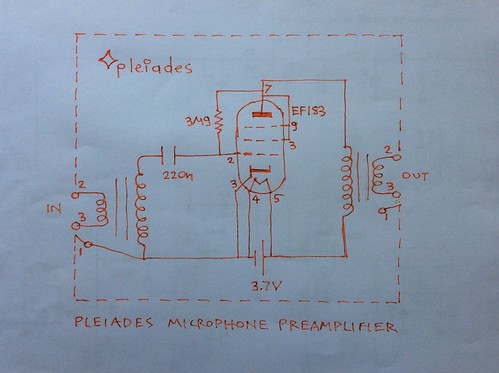It can be seen on the excellent article on the use of electron tubes at 28V from aircraft battery power supply:
28-volts Operation of Receiving Tubes - C. R. Hammond, K. Kohler and W. J. Lattin
The authors had measured a typical potential difference between grid and cathode when there is no grid current of -0.7V, depending on type type. The paper shows an excellent way to calculate this internal bias mechanism when an external resistor is connected using a load line.
For some reason in the paper this, negative internal grid to cathode voltage, is called contact potential.
But it seems to be the exactly the same potential measured on electron tubes on previous Pleiades experiments which appears when the heater voltage is connected to the heaters and the cathode emits electrons. Even before connecting anything to the anode.
The explanation of this negative grid voltage with respect to cathode should be much simpler. The cathode has lost some electrons by thermoemission (to the electron cloud?) and has become positive. Therefore the grid has become negative with repect to cathode.
Furthermore this potential difference between grid and cathode is readily adjustable by varying the heater voltage or cathode temperature.
When as shown in the 28V paper a 2MΩ resistor is connected from grid to cathode the electron tube can operate with 28V at the anode because in fact the bias is pulled up by the connection to the positive cathode. Typical anode currents of 150μA are shown. And there is of course grid to cathode current through the resistor that connects the two.
Had much larger values of bias resistor been used from anode to grid (20-100MΩ) ie Pleiades or anode bias resistor, much higher anode currents should have been possible perhaps even greater than 2-3mA. The grid current would be a small external current from grid to anode.
And if lower values of Pleiades bias resistors are used (typically 4-8MΩ) an electron tube can operate with just 3-6V at the anode. Anode currents of the order or 50-150μA are possible. Plate resistance is low. Transconductance is high for such a low anode voltage. The heater voltage can be reduced as the anode voltage is low. Temperature and secondary emission effects are minimized and the electron tube operates in an ultra low noise or sensitive way with just a small battery supplying both heaters and anode.
The grid bias can be still negative but closer to 0 volts. It is only when the cathode is cold (ie no electron emission) that the potential at the grid is the EMF of the supplying battery, Vb. This mechanism seems independent on the cathode temperature and value of anode (positive supply) to grid resistor. the Pleiades resistor can be directly connected to Vb but in practice the sound quality is even better when the Pleiades biasing resistor is connected to the anode.
An example is the Pleiades V6 microphone head amplifier.

And of course we have the classic paper by Edwin Armstrong explaining how just inserting an unconnected grid dramatically reduces anode current:
References:
28-volt Operation of Receiving Tubes - C. R. Hammond, E. Koehler, J. R. Lattin - Electronics Magazine - August 1944
On Preserving Transconductance of Electron Tubes at Anode Potential as Low as 3 Volts - euroelectron
Operating features of the Audion - E. H. Armstrong
No comments:
Post a Comment